TRAVEL PLANNERS

TENNESSEE TREASURES
BOTANICAL GARDENS






Located minutes from Phoenix Sky Harbor International Airport


Near-perfect weather with 300+ sunny days for outdoor activities and exploration
Award-winning hotels at a variety of costs and price points to fit your budget



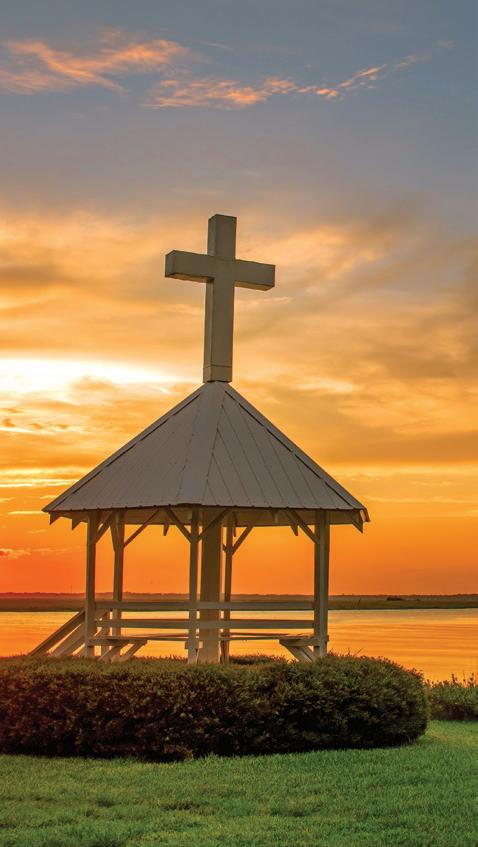

Photo by R. Andres
Mac T. Lacy Founder and Publisher
Charles A. Presley Partner
Brian Jewell
VP & Executive Editor
Herb Sparrow
Senior Writer
Donia Simmons
Creative Director
Ashley Ricks
Graphic Design/Circulation
Rachel Crick
Writer/Project Coordinator
Rena Baer
Copy Editor
Kyle
Telisa Rech
Advertising
Sarah Sechrist Controller and
kyle@grouptravelleader.com

Discover 11 charming waterfront communities and explore 85 miles of beaches while being awed by the wonders of nature at every turn. Plan your next event at crystalcoastnc.org/groups or call 888-891-0021
BY BRIAN JEWELL
Leading group travel isn’t a job everyone can do. Successfully managing a group travel experience requires what Liam Neeson might call “a very particular set of skills.” And while some of those skills may seem intuitive to you as a group leader, others may not come so naturally.
Whether you lead every trip yourself, hire a tour director or partner with a tour company that sends its own escorts, you are ultimately responsible for making sure the person taking your groups on the road has the skills to do it right. That means you need to work on developing these skills in yourself and in the other tour directors you rely on.
Here are five key skill areas that separate great travel leaders from average ones.
Trip leaders have a lot of details to keep track of on the road. They have to manage the itinerary, give the driver directions, communicate with hotel and restaurant staff and ensure that no luggage — or travelers — accidentally go missing along the way. Ideally, they’ll do all this behind the scenes so they’re available to be fun and friendly with their travelers. It takes top-level organizational skills, as well as smart use of organizational tools, to do this well.
Tour directors communicate a lot of important information to their travelers. They must make sure everyone knows where to be and when. They prepare people for what they should wear the next day, help them find the best restaurants for free-time meals and must always be able answer the all-important question, “Where’s the restroom?” Communicating all this information clearly — and in a way that people will hear and remember — takes considerable skill. And it often requires saying the same thing multiple times in different ways to make sure nobody misses it.
Trip leaders don’t necessarily need to be experts in the places they’re taking groups, but they do need to have the navigational skills necessary to show them around. They should be well versed in using maps and GPS apps, and they should familiarize themselves with places they’re visiting ahead of time to be able to help direct travelers to important sites. They also may need to give instructions to a driver or another colleague during the trip, so having a good sense of direction is important.
Though they’re not frequent, emergency situations do come up from time to time during group trips. Whether it’s a passenger who falls ill or gets injured, a hotel or restaurant that loses a reservation, or a weather event that makes part of the planned itinerary impossible, unexpected issues could cause significant disruption. A good trip leader needs the presence of mind and resourcefulness to handle these problems without panicking so that customers never see them sweat.
Leading a group trip isn’t just about handling logistics. One of the most important jobs of a tour director is making sure the people on the trip are having a great time. That requires people skills, such as an outgoing personality, an empathetic ear and the ability to help a group bond while making even quieter travelers feel included. Everyone in the group wants to feel like they’re personal friends with the trip leader, so it’s important for the leader to be friendly and foster those relational connections.





BY WENDY HELFENBAUM

By Dan Brown
Barbecue, blues, baseball and beyond — there’s plenty for groups to love about St. Louis.
Located just south of where the Mississippi and Missouri rivers meet, this vibrant, historic city was the site of the 1904 World’s Fair. Today, its world-class attractions, thriving culinary and arts scenes and abundant green spaces make it an ideal destination for groups, said Brian Hall, chief marketing officer for Explore St. Louis.
“Here, we’re creative and eclectic, with a strong sense of community,” said Hall, citing the architecture behind the current $259 million expansion at the America’s Center Convention Complex. “The concave shape was built to resemble the open arms and Midwestern hospitality you experience when you come to St. Louis.”
With direct flights from 80 U.S. cities to Lambert International Airport, and with onethird of the country’s population within a day’s drive, logistics are a breeze — and so is getting around, Hall added.
“We have a fabulous app-based light rail system, MetroLink,” he said. “From the
convention center, I could hop on a train and be at the airport in 30 minutes, for $2.50.”
It’s easy to plan an itinerary that includes faith-based attractions, such as the Black Madonna Shrine and Grottos, the circa-1830 Historic Trinity Lutheran Church, and the National Shrine of Our Lady of the Snows — one of America’s largest outdoor shrines.
For sports-obsessed groups, the city offers year-round action.
“The St. Louis Blues play at the Enterprise Center, there’s Busch Stadium for the Cardinals, and a brand-new Major League Soccer startup team — plus 8,000 downtown hotel rooms at all price points,” Hall said.
A short walk from Busch Stadium, Ballpark Village features a wealth of entertainment and dining options for groups of 20 up to 8,000. Valley Sports Live is a supersized sports pub, and Cardinals Nation is a clubhouse for fans and foodies. The Crown Room at Budweiser Brew House is an elevated nightlife venue that delivers direct sight lines to the field.
Here are four more ways groups can explore and enjoy the Gateway City.
Discover the country’s smallest national park and tallest human-made monument in the country — the 630-foot-high Gateway Arch, which symbolizes the westward expansion of settlers in the United States. The park’s recent $380 million makeover includes a new underground museum with free admission and redeveloped park land. At the museum, groups can watch a documentary, “Monument to the Dream,” before taking a fourminute tram ride to the top of the arch for panoramic city views. Visitors can tour the newly restored Old Courthouse to stand in the footsteps of American heroes or book a private sightseeing cruise along the Mighty Mississippi.
GATEWAYARCH.COM
Built in 1894, St. Louis Union Station was the busiest train station in the United States during the 20th century. Now, it has been reimagined as a 567-room hotel and indoor-outdoor entertainment complex with a wide array of experience options. It is home to the St. Louis Aquarium, known for its interactive, “handswet” touch tank experiences and more than 13,000 animals, including sea turtles, rays, sharks and otters. From the 200-foot-high St. Louis Wheel, visitors fly high over the city skyline in one of 42 gondolas. Thrill-seekers can try the high ropes course and zipline. Groups can take in a 3D light show, which runs hourly every evening in the Grand Hall, or enjoy a lakeside fire and light show set to music and featuring a 100-foot-tall glowing waterfall.
STLOUISUNIONSTATION.COM
Once a working foundry that fabricated electric motor parts in the 1920s, the sprawling City Foundry now houses St. Louis’ first European-style food hall. Populated by chef-driven restaurants and eclectic boutiques stocking locally made products, craft beer and more, this dynamic venue offers a wristband option so guests can choose from 19 eateries. There are also fun group activities, including Puttshack, an upscale, high-tech, two-level mini-golf facility and restaurant; the Museum of Illusions; Alamo Drafthouse, a 10-screen movie theater and restaurant; City Winery, which hosts live concerts and comedy shows; and Sandbox VR, where groups can participate in one of six immersive worlds for some friendly competition.
CITYFOUNDRYSTL.COM
Home to more than 51,000 plants, the Missouri Botanical Garden is also one of the world’s top three scientific research institutions, working with 140 countries to discover and propagate new plants. The 79-acre facility features many educational programs and workshops for groups. Known for its spherical Climatron greenhouse — the first geodesic dome used as a conservatory — and its unique Japanese garden dotted with bridges around a four-acre lake, the botanical garden welcomes 1 million visitors annually. It hosts special events throughout the year, including Garden Glow from November to January, the Orchid Show in February and Chinese Cultural Days in May.
MISSOURIBOTANICALGARDEN.ORG



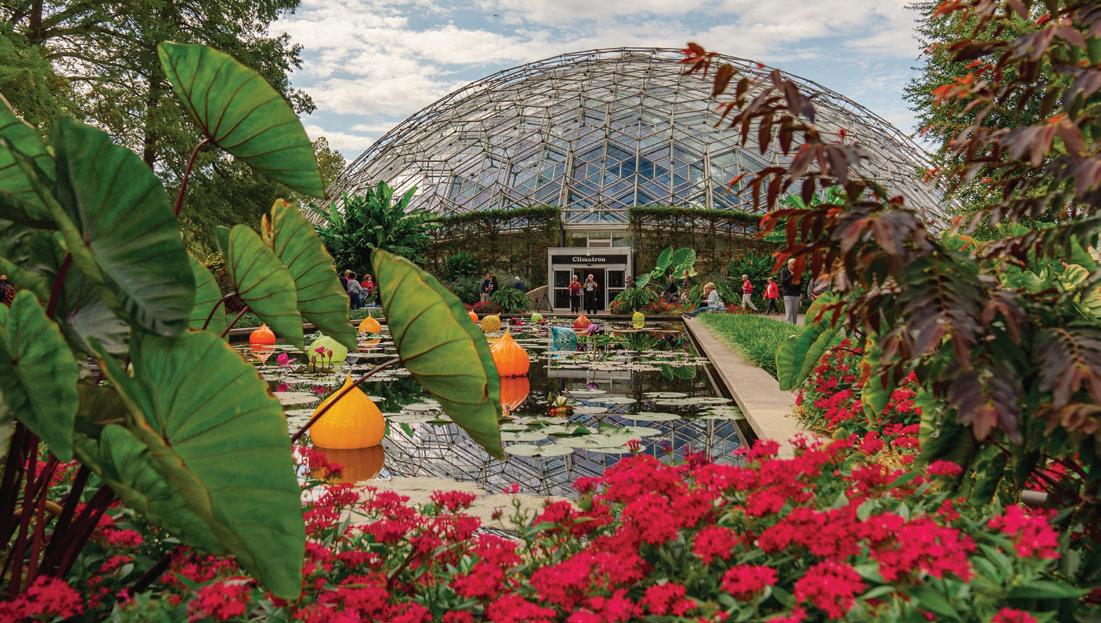

ONE-OF-A-KIND EXPERIENCES AWAIT JUST OFF THE BEATEN PATH


BY TOM ADKINSON
Some Tennessee travel treasures are worth a trip off the beaten path. Tennessee’s major cities are magnets for group tours, offering a wealth of attractions, lodging and dining opportunities. They are destinations unto themselves, but they can also be home base for jaunts outside the metro areas.
This itinerary features some of the lesserknown treasures surrounding Tennessee’s biggest cities. Plan at least five days in the Volunteer State to make the most of these destinations.


Jonesborough is small, with a population of only 6,500, but it has two huge claims to fame. Established in 1779, it is Tennessee’s oldest town, and it is the “Storytelling Capital of the World.” Both accolades attract visitors year-round. The biggest blowout is in October, when thousands celebrate the world’s oldest art form at the National Storytelling Festival. Storytelling occurs other times, too, with the Teller-in-Residence program at the International Storytelling Center, the Jonesborough Storytellers Guild, the Jonesborough StoryTown Radio Show, and during weekend special events and festivals.
Groups can combine storytelling and exercise during walking tours through Jonesborough’s carefully preserved city streets, led by Heritage Alliance guides who wear costumes from the late 19th and early 20th centuries. Visitors learn how the town was briefly capital of the State of Franklin, which functioned as the 14th state but was never recognized by Congress, and how a young Andrew Jackson practiced law here.
In the same county, history much older than Jonesborough’s is the focus of the Gray Fossil Site, which operates in conjunction with the Hands On! Discovery Center, an all-ages science center.
A state highway construction crew chanced upon the fossil site, which held many surprises, including identification of two extinct species new to science, a badger and a red panda. Tennessee’s governor rerouted the highway, and the paleontology work continues to this day. Groups can observe scientists working on the actual dig from May through October and peer inside their working lab throughout the year. Tapirs, mastodons and rhinos are among their finds.
WHILE YOU’RE NEARBY: Nashville is known for country music, but the genre was born in Bristol. The Birthplace of Country Music Museum celebrates a 1927 recording session known as “The Big Bang.”
INFO | jonesborough.com


HIGHLIGHT | HISTORIC VILLAGE AND CUMBERLAND GAP NATIONAL HISTORICAL PARK
Rugby, a British-accented village founded in 1880, is west of Knoxville on the Cumberland Plateau. British author Thomas Hughes inspired the utopian colony that survived for only a decade. Preservation and restoration work over the last half-century has saved its history and several of more than 60 Victorian buildings. Visits begin with Rugby’s award-winning history film, “The Power of a Dream,” and continue with a walking tour that includes the Thomas Hughes Library — believed to be America’s oldest completely preserved public lending library — and picturesque Christ Church Episcopal. The Haunted Village Lantern Tour delivers a detailed history of the social experiment intended to provide a class-free, agricultural community for younger sons of English gentry.
Rugby’s Commissary store offers Appalachian crafts and antiques, and a mile west of the village is a popular food option, the R.M. Brooks Store, a local favorite since 1920 for burgers, barbecue and ice cream. The entire Rugby experience is set amid the natural terrain of the Big South Fork National River and Recreation Area and the Rugby State Natural Area.
East of Knoxville is another historic destination, Cumberland Gap National Historical Park. Bison, Native Americans and then European colonists traversed this key gap in the Appalachian Mountains that became known as the Gateway to the West. In 1775, Daniel Boone was paid to blaze a trail through the gap. Between 200,000 and 300,000 people followed it into the interior of the continent. The 24,000-acre park includes a point where Tennessee, Kentucky and Virginia meet. Park attractions include the mountaintop Hensley Settlement that thrived for 40 years in the early 1900s.
WHILE YOU’RE NEARBY: Downtown Knoxville bustles with activity. Market Square is full of shops and restaurants, and the landmark Sunsphere from the 1982 World’s Fair continues to offer spectacular views. MORE INFO | visitknoxville.com


Everybody screams for ice cream, and travel planners can fulfill that desire at the Mayfield Dairy Farms Visitor Center in Athens, halfway between Chattanooga and Knoxville. T.B. Mayfield Jr. started the farm in 1910, and his little operation grew into one of the South’s most popular dairy brands. The visitor center is at a bustling production plant, not a dairy farm, and tours begin with the making of Mayfield’s signature yellow jugs. Milk production is a blur of activity at 200,000 gallons a day, including filling 3 million half-pint containers every week destined for school cafeterias.
Next is the ice cream facility, where production lines fill everything from pint containers to 3-gallon cartons ready for ice cream parlors. Daily capacity is 42,000 gallons of any of Mayfield’s 60 flavors. When Moose Tracks ice cream is made, the plant needs 11,000 pounds of chocolate a day. The reward at tour’s end is a scoop of ice cream. Look for Mayfield’s costumed mascot, Maggie the Cow. It takes 20,000 real Maggies to keep the operation going.
A quite different activity is 11 miles away in Sweetwater. The Lost Sea Adventure is a cave tour with a bonus — a boat trip on the largest underground lake in America. The three-quarter-mile trip is gentle on the way down and steep on the way up. The 4.5-acre lake is 140 feet below the surface, and glass-bottom boats powered by electric motors ease through its calm waters. The massive, stocked trout swimming deep underground grow large because of regular feeding and the absence of predators.
The cave itself is full of stories: jaguar bones from thousands of years ago, prehistoric human visitation, Civil War saltpeter mining, a teenager’s discovery of the lake in 1905 and rare crystalline formations called anthodites.
WHILE YOU’RE NEARBY: Three signature attractions on Lookout Mountain — the Incline Railway, Ruby Falls and Rock City — will forever be popular for Chattanooga tours.
MORE INFO | visitchattanooga.com








Franklin is only 25 miles from downtown Nashville, but it is worlds apart. Founded in 1799, it is among Tennessee’s oldest communities and is dripping in history. Its photogenic downtown is vibrant — pleasantly lacking much intrusion from national brands — with local restaurants, shops, art galleries and historic homes. Travel + Leisure put it on its “10 Best Main Streets in the USA” list, and Visit Franklin spokesman Matt Maxey compares it to a Norman Rockwell painting or a Hallmark Channel movie setting, which it has been.



Franklin is a breeze for dispersing your group for walkabouts. At one end is Landmark Booksellers, a cozy bookstore in a building that Davy Crockett, Sam Houston and Andrew Jackson all visited, and the MooreMorris History and Culture Center of Williamson County, which occupies a 1905 structure built as the town jail. The town square showcases detailed plaques telling “the Fuller Story,” the harsh realities of a slave economy, Reconstruction and the Jim Crow era. A courthouse statue installed in 2021 honors the 300 formerly enslaved men who enlisted in the Union army there. The Franklin Theatre, a 300-seat movie palace from 1937 and restored in 2001, is farther down Main Street.
An aviation surprise awaits visitors south of Franklin. The Beechcraft Heritage Museum in Tullahoma is a sprawling collection of hangars devoted to Beechcraft airplanes. Walter Beech, the popular airplane’s namesake, was born nearby. He flew a glider he designed in 1905 and was a World War I pilot and a test pilot after the war. He, his wife and three others created their airplane company in Wichita in 1936 and gained fame with their speedy Beechcraft Staggerwing biplane. The museum has 39 Beechcraft planes and seeks to acquire an example of every model built.
WHILE YOU’RE NEARBY: The Grand Ole Opry is important on any Nashville itinerary. That’s especially true in 2025, the famous radio show’s 100th year on the air.

In a state of natural wonders, Reelfoot Lake has the weirdest origin. The 15,000-acre lake, Tennessee’s only natural lake, resulted from earthquakes over the winter of 1811-1812 that forced the Mississippi River to flow backward and flood a cypress swamp. Graceful, sometimes eerie-looking cypress trees surround the lake that has became a destination for waterfowlers, anglers and birders.
A few decades ago, bald eagles wintered here and became a visitor attraction, but the climate has changed, and the impressive birds now are year-round residents. Approximately 150 nesting pairs are in the lake’s vicinity. Pontoon boat cruises, especially sunset cruises, are popular. Reelfoot Lake State Park offers a program with its collection of raptors that cannot survive in the wild. For a big meal, check out Boyette’s Dining Room, a regional destination for catfish, country ham and fried chicken since 1921.
Nearby, Discovery Park of America is a manmade attraction in Union City, a gift from Robert Kirkland, the founder of Kirkland’s Home stores, to his birthplace region. His international travel sparked the idea of a place where people could see sights and be exposed to ideas beyond the limitations of where they lived.
Discovery Park’s centerpiece is a 100,000-squarefoot building with nine exhibit galleries. Displays delve into natural science, outer space, Native American history, pioneer settlement, military equipment, aviation and historical figures. There’s even an earthquake simulator as a tribute to the quakes that formed Reelfoot Lake.
WHILE YOU’RE NEARBY: Memphis means music and food. Explore the music scene at the Memphis Rock ‘n’ Soul Museum and Stax Museum of American Soul Music. To please your palate, sample barbecue at Rendezvous, Blues City Cafe and Central BBQ, or go for the poultry at Gus’s World Famous Fried Chicken.


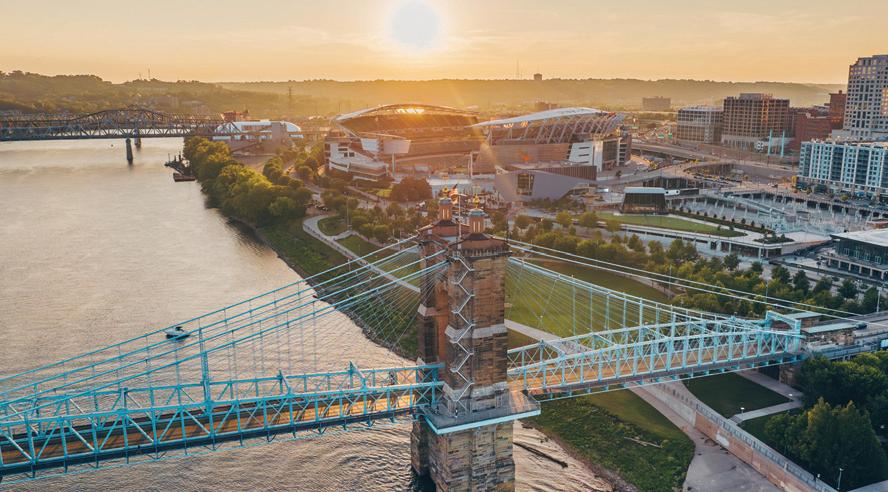





































BY RACHEL CRICK

Groups seeking a slice of heaven should look no further than a faith-based retreat.
What could be better than a weekend getaway enjoying the beauty of nature and the company of a spiritual community? A few days away from the hustle and bustle of everyday life is critical for restoring one’s mental and physical health and replenishing one’s energy, which is what makes retreats such valuable experiences. Faith-based retreats offer the additional benefit of making guests feel more connected with God and more in touch with their spirituality.
For a little spiritual R-and-R, groups can head to these faith-based retreats across the country.



Set on nearly 100 acres beside the historic Frederica River and the Marshes of Glynn Overlook Park on St. Simons Island, Epworth by the Sea is a conference and retreat center that combines the beauty of the Georgia coast with an active spiritual community. Bought by the Methodist Church in 1949, the property has a long history, first as a cotton plantation, then a lumber mill and today as a popular retreat. It welcomes many types of faith-based and nonprofit groups, from Christian youth groups to Jewish groups. During some years, the retreat draws as many as 700 different organizations to its waterfront Georgia campus.
“We’re on the river, surrounded by live oak trees with Spanish moss, so it’s really idyllic and peaceful,” said Joel Willis, president and CEO at Epworth by the Sea. “We have a prayer tower that plays hymns every hour, and I think people like to come because of the atmosphere here.”
The retreat requires a 10-person minimum but can host groups as large as 900. It has 235 guest rooms and 35,000 square feet of meeting space for groups to use. Meals are served cafeteria-style in three dining rooms.
While at the Epworth by the Sea, guests can enjoy plenty of physical exercise at the retreat’s tennis courts, basketball pavilion, pickleball courts and the swimming pool, which is open seasonally. A ropes course is available for team building. Participants can walk or cycle around the property or fish at the piers on the river.
While not officially offered by the retreat center, many groups head to other parts of the island for dolphin tours. There’s also a historic chapel built in the 1880s — the oldest on the island — which offers 30-minute worship services every Sunday.
epworthbythesea.org
White House Jesuit Retreat was created 103 years ago for the same purpose it serves today: to give individuals the space to reconnect with God and their sense of spirituality. The retreat center is located on the banks of the Mississippi River just south of St. Louis. The Jesuit Order is based on the spiritual teachings and exercises of St. Ignatius, teachings that are reflected throughout the retreat.
“We’ve had people that come here 75 times, but they come back year after year because it helps their spirituality, it gives them a boost,” said Bill Schmitt, executive director at the retreat center. “It’s a renewing of your association and your relationship with Christ and God.”
White House hosts a three-day retreat every weekend of the year, from Thursday evening to Sunday afternoon, in addition to some private retreats during the week. The campus capacity is 90 people, so groups of 90 or fewer can book space during any weekend with enough available accommodations. The center typically hosts retreats for as many as 4,500 people of many different faiths each year. There is no fixed charge for these retreats, only a requested free-will donation from the retreatants.
The three-day retreats differ from many others because they are silent, which allows maximum time for rest and reflection. Following the first evening meal, the center requests that attendees only speak in designated places at certain times. Guests each get a simply furnished bedroom and their own bathroom. There are 10 scheduled talks in the chapel based on the Jesuit tenets, time for one-on-one conferences with a priest and daily mass and benediction services. Guests are served three meals a day. In between these scheduled activities, they are free to walk the grounds on the Ignatius Walking Trail, a wooded walking trail with views of the property and the surrounding bluffs.
whitehouseretreat.org



Christian groups will find sanctuary and fellowship in the mountains of East Pennsylvania at Blue Mountain Christian Retreat and Conference Center. Founded in 1974 by a husband-and-wife team who immigrated from Switzerland, the center was opened to spread the Gospel, provide sanctuary from the chaos of the world and let retreatants enjoy the company of other followers of Christ. This labor of love began as a single building for up to 35 guests and has grown into a large campus that can accommodate up to 400 with a variety of lodging, from apartments to dorms.
The center can host large and small Christian groups for retreats, including church groups, youth groups and even Christian corporate groups. Its 375-acre campus offers a serene environment for guests to enjoy nature and reconnect with God. But there’s also a wide variety of outdoor activities for a more active retreat, from ultimate Frisbee to hiking trails and swimming. Retreatants can watch movies under the stars or enjoy s’mores around a campfire. There’s also a gymnasium, basketball courts, a tennis court, volleyball court and baseball and soccer fields. For rainy days or cooler weather, guests can play ping pong, foosball, shuffleboard or board games. Meals are served buffet-style, and groups can request additional snacks and beverages.
The on-site chapel is a great place for quiet reflection and prayer, as well as regular worship services throughout the week. The center is known for hosting lectures and services from prominent guest speakers, such as Christian authors, scholars, pastors and thought leaders.
bmcr.org


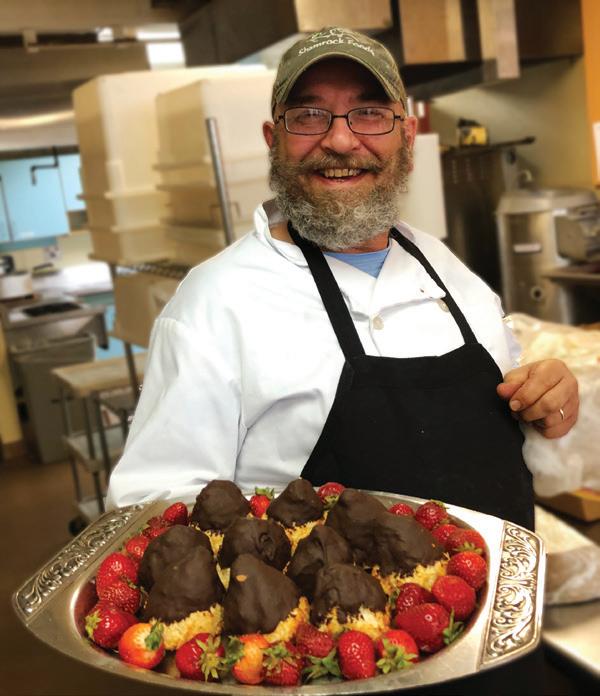



Sunrise Ranch in Loveland, Colorado, has been a place of learning and restoration since its founding in 1945. The ranch sits on 400 acres in the foothills of the Rocky Mountains, about 70 miles north of Denver. The ranch is a place of residence for about 70 people who compose its community. It also frequently welcomes teachers and spiritual leaders to host workshops and classes. It features plenty of accommodations for guests and welcomes groups as small as 10 or as large as 120 for retreats.
“From the beginning, it’s been an intentional, spiritual community,” said David Karchere, spiritual director at the ranch. “People come to learn, renew and transform.”
Group programming for retreats is highly customizable, whether they’re seeking courses on spiritual attunement or personal growth workshops. The ranch has meeting rooms for groups to use for their own activities. In addition to spiritual programming, guests can hike through the scenic valley surrounding the main campus, where they may glimpse some of the abundant wildlife, such as elk, fox, deer and many species of birds. The retreat also offers a swimming pool, sauna and hot tub, as well as massages. Worship services are offered on Sunday mornings and Wednesday evenings.
The ranch is known for its high-quality, farm-to-table food that promotes physical wellness and accommodates a range of diets. Grass-fed beef and seasonal produce are sourced directly from the ranch, and every meal is scratch made with local ingredients.
sunriseranch.org
About two hours north of Seattle, near the Canadian-Washington border, groups will find a peaceful getaway that combines the beauty of the Pacific Northwest with a cozy faith community. Cedar Springs Christian Retreat Center in Sumas, Washington, is located in the foothills of the Cascade Mountains and was purchased in 1974 by the Bargen family. They felt called to build a retreat center, and they opened the Chalet Lodge and began hosting groups for retreats in 1982.
Since then, three more lodges have been added, bringing the total number of lodge rooms to 58. Rooms are spacious, motel-style accommodations that can sleep between two and four people and come with their own private bathroom and Wi-Fi. Each lodge has a meeting room groups can use for their own programming, if desired. Additional cabins on the property offer five more sleeping rooms. The property is also known for its delicious cuisine, prepared with fresh, seasonal ingredients and served family-style.
Cedar Springs is renowned for its striking landscaping and its surrounding nature. It has eight acres of gardens and hiking trails. With several ponds and water features, the center offers guests plenty of peaceful waterfront views. In the warmer seasons, the grounds explode with the blooms of thousands of multicolored flowers and trees. The layout of the gardens provides nooks for retreatants to enjoy the property’s beauty and connect with nature. During the cooler seasons, groups can cozy up around a firepit or hike through the surrounding forest to take in the mountain scenery.
cedarspringscrc.org


Around the country, beautiful things are growing at America’s botanical gardens.
For avid horticulturists and simple nature lovers alike, visiting gardens promises refreshment and relaxation. Each garden — urban or suburban, intricately designed or wild and unplanned — is an oasis with a distinct personality and vibe. From the East Coast to the West, here are five notable gardens that will immerse your group in nature’s beauty and the changing seasons.

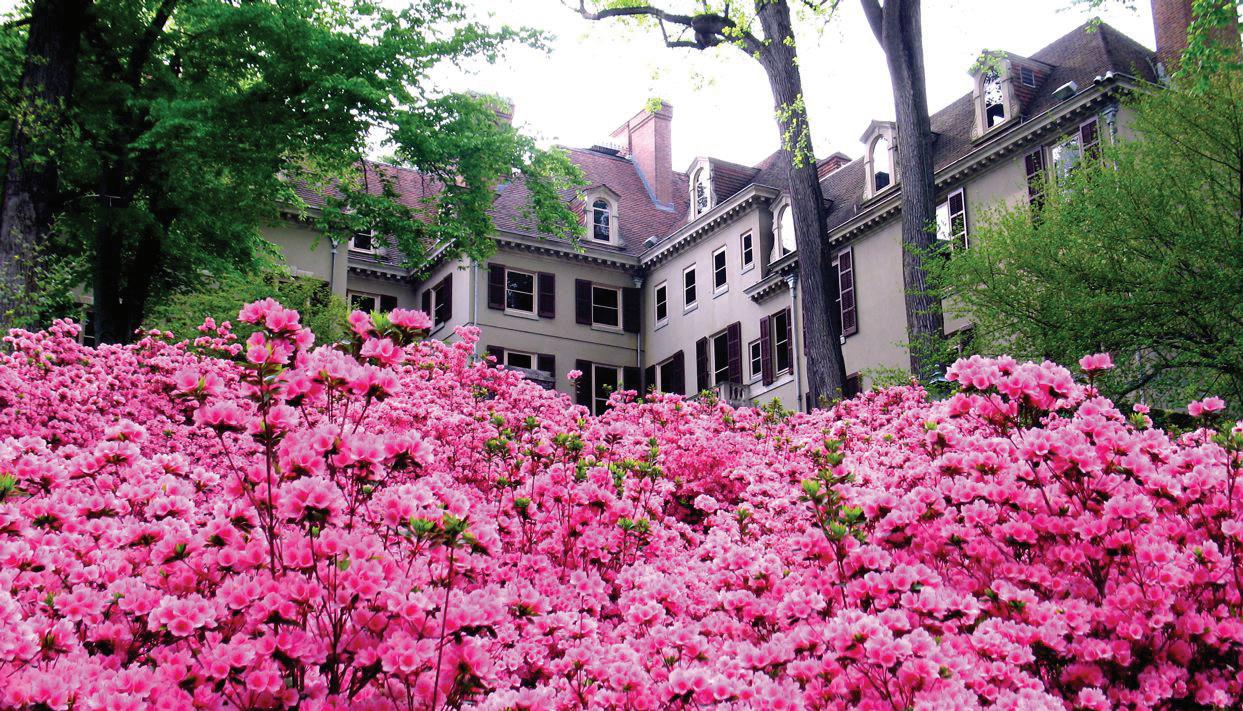

Once part of a turn-of the-century working estate, Winterthur Museum, Garden and Library in Winterthur, Delaware, had its own train station, as well as a post office that still operates today. At Winterthur’s apex, the property exceeded 2,500 acres and 250 workers. Today, it encompasses 1,000 acres of protected meadows, woodlands, ponds and waterways, including a 60-acre wild garden designed by industrialist Henry Francis du Pont, who was born at Winterthur.
“These are naturalistic gardens designed to look like they’ve not been designed,” said Christine Heesters, Winterthur’s director of marketing and technology. “A 30-minute tram tour is the best way to see our hilly gardens that are known for their successive waves of color.”
In the 1920s, du Pont collected historic American furniture, art and decorative objects. He enlarged his family home to accommodate them and added architectural elements from other early-American houses. Today, the 175-room mansion displays nearly 90,000 objects made or used in America since 1640. An introductory tour showcases two floors of the mansion, while a deeper-dive 75-minute tour takes visitors to additional floors, and two customizable tours are based on interest.
Events coming next year include the exhibition Almost Unknown: The AfricAmerican Picture Gallery, opening May 3. The 46th annual Point-to-Point Steeplechase, May 5, is a longstanding Delaware horse race across Winterthur’s rolling hills with lavish tailgates, fanciful hats and activities. The Artisan Market, July 18–20, features nearly 100 of the region’s talented craftspeople. Winterthur’s Delaware Antiques Show, November 7–9, invites premier dealers of Americana. Yuletide at Winterthur decks out the mansion and features a holiday market. Year-round happenings include lectures by the research library team, guided garden walks and conservation clinics.
winterthur.org
Art and nature take center stage at Frederik Meijer Gardens and Sculpture Park in Grand Rapids, Michigan. Celebrating its 30th anniversary in 2025, the 158-acre garden features more than 200 outdoor sculptures, Michigan’s largest tropical conservatory and a five-acre children’s garden. Narrated tram tours wind through garden pathways, and visitors can stroll nature trails.
“Before walking through it, I recommend taking the tram to get a sense of the enormity and quality of our sculpture collection,” said Janet Korn, senior vice president of Experience Grand Rapids. “The gardens were recently awarded Best of the Best in Group Tour and Travel for 2024 by the American Bus Association.”
According to Korn, the centerpiece “American Horse” sculpture was specifically created from a project that Leonardo DaVinci envisioned but abandoned due to war. Meijer commissioned molds from DaVinci’s drawings and cast them. One of the horse sculptures resides here while the other stands in Milan, where it was originally intended to be installed.
Music abounds in the garden concerts that take place regularly during the summer months. Terraced lawn seating provides lovely garden views, and food and drinks are available. Tuesday evenings, local and regional musicians and cultural organizations grace the amphitheater stage. During July and August, a series called Sunday Strings features live chamber music.
Events include the spring and fall Master Lecture Series, which invite worldrenowned gardeners, artists, authors and speakers. In spring, butterflies return

to the Lena Meijer Tropical Conservatory. October’s Mums at Meijer Gardens features chrysanthemums, fall foliage and family-friendly activities. Thanksgiving through New Year’s, Enlighten captivates with art, light, music and nature.
meijergardens.org
DESERT BOTANICAL GARDEN PHOENIX
Showcasing the Sonoran landscape, the Desert Botanical Garden in Phoenix juxtaposes towering saguaros, beach-ball-shaped cacti, native wildflowers, fleshy succulents and wispy Palo Verde trees. The garden is located by the red buttes of Papago Park near downtown, and its five looping trails showcase diverse habitats. Hummingbirds, Gila woodpeckers, quail and diverse wildlife call this garden their home, while thousands of butterflies spread their wings in the lush butterfly pavilion.
“It’s a magical moment when people realize how colorful the desert is and get up close and personal with a saguaro,” said Sarah Doyle, director of communications for Visit Phoenix. “Saguaros only grow in the Sonoran Desert and have been federally protected since the 1930s, with the largest concentration in Arizona and metropolitan Phoenix.”
Docent-led tours highlight the garden’s living collection. Gardening classes explore desert native pollinators, composting, propagation and landscaping. Additional classes feature photography, cooking demos, art and wellness. Rounding out the garden’s extensive events are concerts featuring local musicians on Friday evenings or Sunday afternoons. Groups can dine at Gertrude’s or the Patio Café.




The much-anticipated Devour Culinary Classic in February offers tastings of more than 70 regional food and beverage businesses. The event combines horticulture, live music and the arts, and each visitor takes home a commemorative wine glass they’ve used for wine sampling. During the holiday season, Las Noches de las Luminarias features nearly 7,000 hand-lit luminaries lining the paths under mesquite and Palo Verde trees robed in holiday lights. Performers play music while visitors enjoy catered cuisine, wine and cocoa.
dbg.org
Ocean vistas frame many of the San Diego Botanic Garden’s 29 themed areas. Located on the coast in Encinitas, California — 30 minutes north of downtown San Diego — the garden supports more than 5,300 plant species and varieties from numerous microclimates around the world, such as desert landscapes and tropical rainforests. Visitors can stroll four miles of trails, and the Overlook Tower affords 360-degree views.
The Bamboo Garden, home to the largest living bamboo collection in North America, features more than 100 species from around the globe. The 8,000-square-foot Dickinson Family Education Conservatory houses one-of-akind plant chandeliers and rare tropical plants. Demonstration gardens host classes and programming. Classes span succulent arrangements, jewelry making, wellness and a monthly science seminar featuring talks with garden experts.
“Our garden has one of the five Mediterranean climates in the world,” said Ari Novy, president and CEO of the San Diego Botanic Garden. “There’s very little to no rain in the summer, so the flora has adapted to a growing season that runs from November through March or April. In summer, we can irrigate and grow tropicals, which gives us a tremendous palette of plants.”
Guided tours, including butterfly walks, are offered June through October. Birding specialists lead bird walks, which are held before the garden opens on the first Monday of each month. The holiday season brings a dazzling trail of more than 1 million lights intermingled with artwork throughout the garden.
sdbg.org

Synchronizing nature, architecture and art, the Portland Japanese Garden in Portland, Oregon, exudes peace and contemplation. The garden is a living cultural exchange nestled in Washington Park, and visitors will delight in five historic gardens and three newer areas, as well as a Japanese Tea House, the site of tea ceremony demonstrations. Views of Mt. Hood and downtown serve as a backdrop to pathways that parallel streams and ponds, bonsai trees and cherry blossoms in the spring.
Visitors first enter the Cultural Village designed by world-renowned architect Kengo Kuma, one of today’s most significant contemporary Japanese architects. Traditional Japanese arts take place here with more than 150 events annually, including festivals, demonstrations, art exhibitions, performances and lectures. The garden has successfully introduced the work of more than 75 artists representing Japan, from internationally known names to young artists and artisans.
Umami Café serves Japanese-produced green teas and traditional dishes, such as yakitori fried rice, matcha brownies and mochi ice cream. The gift shop sells hand-selected items from Japan. An annual summer marketplace called Behind the Shoji carries curated items from the Tokyo International Gift Show and from meetings with craftspeople in their studios and stores.
“As far as I’m aware, there are only three places in the world that serve Jugetsudo tea — Japan, Paris, and Portland,” said Will Lerner, the garden’s communications manager. “Once or twice a year, our buyer visits Japan to procure products and crafts, and we offer wares that people might not be able to find, even if they visit Japan.”
japanesegarden.org





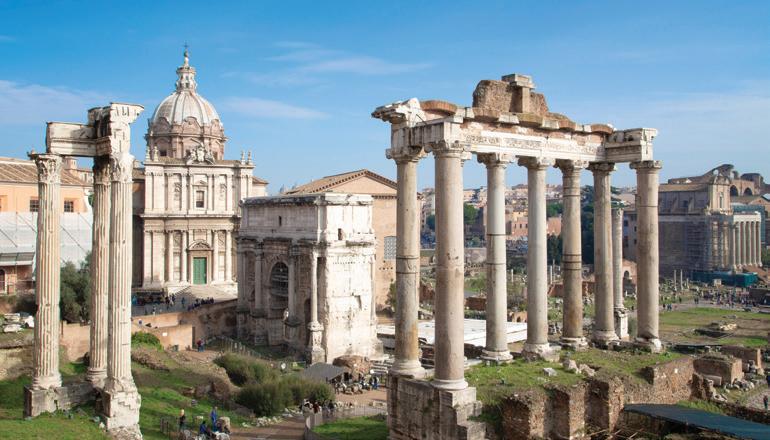
IBY DIANA BOCCO
taly is a land that stirs the soul. From ancient ruins to Renaissance art and culinary traditions that shaped the world, every region has a story to tell.
History here is not confined to museums, though — it lives and breathes in medieval palaces, Roman amphitheaters and Renaissance masterpieces. Yet Italy is just as much about its people and the passion that infuses every dish, every conversation and every piece of art. Groups visiting will find themselves captivated not only by the grandeur of the Colosseum or the beauty of Michelangelo’s “David,” but also by the simple pleasure of an espresso enjoyed at a sunlit café.
Beyond its historical treasures, Italy is also home to incredible nature. The azure coasts of Amalfi, the rolling vineyards of Tuscany and the snow-capped peaks of the Dolomites are just a few examples of its natural beauty.
Italy invites visitors to lose themselves in the heart of la dolce vita — no matter if they’re standing beneath the Sistine Chapel’s frescoes, gliding through Venice’s shimmering canals or trying freshly made pasta in a rustic trattoria.
Tourists flock to Rome for iconic landmarks like the Colosseum, the Roman Forum and the Trevi Fountain. But the “Eternal City” is a living museum where ancient ruins can be found around every corner, sitting next to lively piazzas or Baroque masterpieces. Those looking for a more intimate experience can wander the cobblestone streets of Trastevere, where artisanal shops and cozy trattorias exude authentic Roman charm. And although Vatican City is technically an independent city-state, its location within Rome makes it an unmissable part of any visit to experience treasures like St. Peter’s Basilica and the Sistine Chapel.
VENICE
Venice, the “Floating City,” is a marvel of art, history and engineering. Its network of canals winds through centuries-old palazzos, landmarks and squares. Group travelers can admire the grandeur of St. Mark’s Basilica and the Doge’s Palace or take in the bustling markets and historic charm of the Rialto Bridge. For art and history enthusiasts, the Gallerie dell’Accademia showcases Venetian masterpieces, while San Giorgio Maggiore offers panoramic views of the city from its bell tower. Nearby, Murano’s glassblowing studios and Burano’s brightly painted houses provide unique group excursions. At the end of the day, nothing beats unwinding with gelato or a spritz while people-watching at Piazza San Marco.
With its dramatic cliffs, pastel-hued villages and turquoise waters, the Amalfi Coast feels like a dream. Here, charming towns like Positano and Ravello welcome visitors with breathtaking views and winding streets filled with boutiques. Outdoor lovers can tackle the Path of the Gods, a scenic hike offering sweeping views of the Mediterranean, then sit in one of Amalfi’s many waterfront cafes for some fresh seafood, zesty limoncello and the region’s famed lemon desserts. Just a short boat ride away, Capri offers the enchanting Blue Grotto and stylish shopping streets to explore.

FAITH HIGHLIGHTS: Nestled in the Umbrian hills, Assisi is the birthplace of St. Francis and a spiritual haven. The Basilica of St. Francis of Assisi, adorned with Giotto’s frescoes and intricate stonework, is a masterpiece of religious art and architecture. A UNESCO World Heritage Site, this serene town attracts pilgrims and travelers alike and offers a great mix of medieval streets, peaceful chapels and scenic views of the Italian countryside.

HISTORIC EXPERIENCE: Groups can step back nearly 2,000 years with a visit to Pompeii, where volcanic ash from Mount Vesuvius preserved an entire Roman city. Here, it’s possible to walk the ancient streets, explore beautifully preserved villas, and marvel at frescoes and graffiti that provide an intimate glimpse into daily life.

SIGNATURE FLAVOR: Italy’s culinary heart beats with fresh pasta. With tagliatelle al ragù in Bologna, creamy cacio e pepe in Rome and silky ribbons of pappardelle with wild boar in Tuscany, pasta is a unifying symbol of Italian tradition. Each region boasts its own specialties, too, offering endless opportunities to enjoy this beloved dish.

JUST FOR FUN: Whether it’s rolling fresh pasta, mastering the art of pizza-making in a Tuscan villa or preparing a truffle-inspired feast after a hunt in Umbria, cooking classes offer visitors a chance to roll up their sleeves and create authentic dishes. Groups can bond over rolling dough, sipping local wine and enjoying their homemade Italian feast.

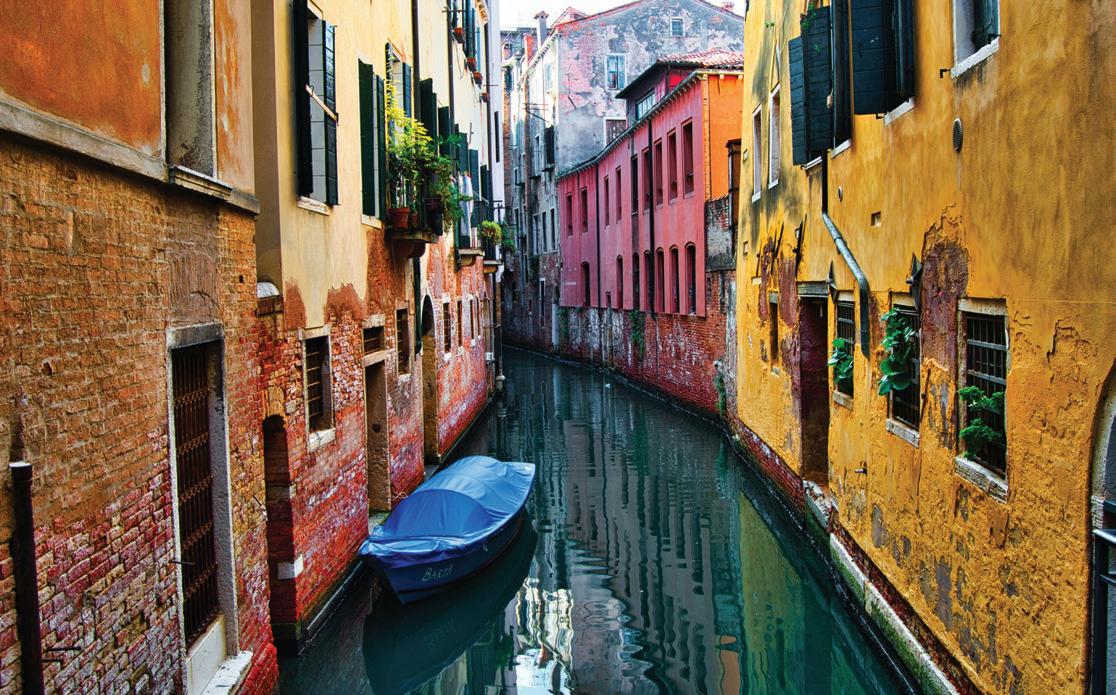

BY RACHEL CRICK
Mammoth metros like New York City and Boston are known for their museums, from The MoMA and The Met to the Isabella Stewart Gardner Museum and the Boston Tea Party Ships and Museum. But visitors are missing out if they stop only at these famous sites.
Thanks to its centuries of recorded history, the Northeast and MidAtlantic regions of the country have a dizzying number of museums worth visiting, with focuses ranging from world-renowned art to local history and culture. To fascinate any group, take them to a stop on this eclectic list of lesser-visited — but no less fascinating — museums.



In 1620, the Mayflower landed at Plymouth Harbor after crossing the Atlantic Ocean. It carried 102 pilgrims that fled England seeking religious liberty. That makes where they settled in Plymouth, Massachusetts, the oldest town in New England and one of the oldest in the U.S. The history of the pilgrims, from their fraught journey across the Atlantic to the signing of the Mayflower Compact and their relationship with Indigenous tribes, is commemorated at Plimoth Patuxet Museums. Founded in 1947, the museum has grown to include an English village set in 1627 and a Patuxet Homesite, where visitors can learn about the Indigenous people who populated the area prior to the pilgrims’ arrival. There’s also the Plimoth Grist Mill and the Mayflower II, a replica of the ship, both of which visitors can tour.
Groups can explore the museums to see re-enactments of daily life in the 17th century among the pilgrims and Indigenous people. They can listen to talks about or watch re-enactments of the daily lives and histories of the pilgrims. The museum also offers the option for groups to enjoy a family-style meal consisting of food the pilgrims or Indigenous people ate. For supplemental education, a set of 14 short films in a series called “The Light Here Kindled” is available to watch prior to their visit.
“One of the reasons we’re so popular with faith-based travel groups is the amount of scholarship and research we’ve done,” said Richard Pickering, deputy executive director and senior historian at Plimoth Patuxet Museums. “The representation of the faith experience is very accurate to that of the 1620s. For a lot of people, they’re just beginning to learn about the challenging experience of Christianity during that time.”
plimoth.org

To skip the crowds at D.C. museums, groups can head to the second location of the Smithsonian’s Air and Space Museum, which can be found at the Dulles International Airport in Chantilly, Virginia. Known as the Steven F. Udvar-Hazy Center, it opened in 2003 and sees an average of 1.2 million visitors each year. The center features more than 3,000 artifacts on display, including more than 200 aircraft and a large military history collection. It’s also home to some of the museum’s larger and more significant artifacts, such as the SR-71 Blackbird, Space Shuttle Discovery and the Air France Concorde. Free guided tours of the center are a must, thanks to its experienced volunteer docents.
“Many of them have a lot of experience with the artifacts, sometimes even the exact artifact on display,” said Holly Williamson, public affairs specialist at Smithsonian’s National Air and Space Museum. “Two of them flew the SR-71 Blackbird. One was an engineer for NASA, and there are former flight instructors and medevac helicopter pilots. They bring their personal knowledge and combine it with our collection, and the stories we have make for a really great tour.”
In addition to guided tours, the center offers free admission and bus parking. Its IMAX theater offers group discounts for groups larger than 10, and the center’s on-site restaurant, Shake Shack, accepts group vouchers. Student groups can take advantage of the classroom lab spaces for a hands-on activity, lecture or demonstration. The center also hosts annual activities, such as an outdoor aviation show that takes place the day before Father’s Day. Groups should call in advance to schedule guided tours or to reserve classroom spaces.
airandspace.si.edu/udvar-hazy-center
While technically a branch of New York City’s Metropolitan Museum of Art, The Met Cloisters are at a different location than the famed Fifth Avenue museum. The Cloisters can be found in Upper Manhattan, overlooking the Hudson River from Fort Tryon Park. The Cloisters, the surrounding land and 40 pieces of medieval art from his personal collection were gifted to the museum by John D. Rockefeller in the 1920s.
A cloister refers to a covered walkway and open courtyard; The Met Cloisters contain five of these medieval structures, which consist of parts of European monasteries that were deconstructed and reconstructed in Manhattan. These cloisters act as walkways from one museum building to another and provide more architectural context to the museum’s subject matter. They also enclose the museum’s three beautiful gardens, each of which feature plant life reminiscent of a European garden in the Middle Ages. The museum is the only one in the country dedicated exclusively to the art and architecture of Medieval Europe. Highlights of the collection include a prayer book owned by the queen of France, stained glass windows from an Austrian castle’s chapel, the Mérode Altarpiece and the Unicorn Tapestries. Sculptures, tapestry, metalwork and other mediums used during the Middle Ages in Europe are featured throughout.
Groups larger than 10 can schedule a tour at The Met Cloisters with advanced reservations. They can opt for a guided tour or self-guided audio tour of the museum. Trie Café is open from April to October and lets museum guests enjoy outdoor scenery with casual fare. Groups can round out their visit with a trip to the museum shop.
metmuseum.org/cloisters




Renowned for his lasting impact on American literature, Mark Twain wrote some of the most well-known novels of the 19th century. Works like “The Adventures of Tom Sawyer” and “Adventures of Huckleberry Finn” transformed the zeitgeist with their use of satire and social commentary. But the author behind these works is equally worthy of note; after all, many people don’t know that Twain’s real name was Samuel Clemens. To discover more about this talented writer, groups can head to The Mark Twain House and Museum in Hartford, Connecticut. Construction of the author’s former home was completed in 1874 for Clemens, his wife and their three daughters.
Now a museum, the American High Gothic-style home celebrated its 150th year throughout 2024. The three-story home is furnished in a style similar to that of the Clemens family. Also on the property are beautiful grounds and a visitor center and museum building. Up to 14 people at a time can be taken into the home for a guided tour. Larger groups can be divided up and go in shifts to tour the home, explore the museum grounds and see exhibits and a documentary film on Clemens’s life. If they desire, groups can enjoy a catered meal at the museum or picnic on the grounds.
“The Mark Twain House is a beautiful building, and the story of Mark Twain’s life is fascinating,” said Rebecca Floyd, director of interpretation at The Mark Twain House and Museum. “A lot of people have no idea about the intricacies of his life and how important his family was to him.”
marktwainhouse.org
Just outside of Burlington, Vermont, groups will find the Shelburne Museum, an institution dedicated to collecting and displaying art, architecture and Americana. Founded in 1947 and opened in 1952, it’s Vermont’s largest museum and the largest art and history museum in northern New England. It’s open May through October and features holiday light events on select dates November through early January. The 39-acre campus features 39 buildings, many of which are historic structures that were relocated to the campus and are artifacts in and of themselves. It also has 22 gardens and a sidewheel steamboat, Ticonderoga.
Among its collections are Impressionist paintings by greats such as Mary Cassatt, Claude Monet and Edgar Degas. It also has works by American artists like Andrew Wyeth and Martin Johnson Heade. That’s in addition to an eclectic collection of sculptures, toys, horse-drawn vehicles, duck decoys, textiles, firearms and folk art.
Groups can meander through the massive campus at their leisure to see the artifacts of greatest interest to them. Or they can stroll the gardens and see the distinct buildings, such as the historic general store, schoolhouse, lighthouse, round barn and the Ticonderoga steamboat.
shelburnemuseum.org



















The Harvey B. Gantt Center is named for Charlotte’s first Black mayor and is filled with artwork by Black artists.
BY RACHEL CRICK
AFRICAN AMERICAN CULTURAL CENTERS GO BEYOND TEACHING HISTORY.
They weave together stories of Black art, music, cuisine and innovation to explore what it means to be Black in America. They also are gathering spaces for community events, workshops and celebrations.
With their emphasis on education and enrichment, these centers are hubs for learning and personal growth, and excellent stops for meaningful travel experiences. Here are some spaces across the country where visitors can experience Black culture in its richest form.

The Charles H. Wright Museum of African American History, simply called “The Wright,” is one of the oldest institutions chronicling African American history and the world’s second-largest museum dedicated to Black history. Charles H. Wright, a Detroit physician, founded the museum in the basement of his medical practice in 1965. It moved to a larger building in the 1980s and then again in the ’90s to keep up with its growing collections. It was officially dedicated to Wright in 1998, four years before his death.
Today, The Wright houses more than 35,000 artifacts and has rotating exhibits that explore many facets of African American culture, from historical figures to photography collections that look at the world through the lens of Black culture.
In addition to guided or self-guided tours, groups can sit in on one of the museum’s many public programs held in a newly renovated theater. A popular program there brings in artists and notable local or national figures for educational talks or theater and dance performances. Other museum programming is organized around holidays and includes celebrations for Martin Luther King Jr. Day, Juneteenth, the Annual African World Festival and Kwanza. Catered meals can be arranged on site.
“There’s not only learning here, but celebration, and when it comes to the activities and exhibitions we host, they are immersive,” said Jonathan Jones, manager of youth and family programs. “I have yet to meet anyone who has not had some very impactful experience once they’ve entered this institution.” thewright.org
D.C.’s dizzying array of museums provides groups with an abundance of options, but for Black culture, the choice is obvious — The National Museum of African American History and Culture. It is far bigger than it appears because half of its 10 floors are underground. Wide-ranging exhibits provide a comprehensive portrait of African American history and culture, from fun exhibits on Black influence in the music industry and pop culture to somber explorations of darker chapters of Black history.
This Smithsonian Institution museum realizes some of its galleries induce powerful emotions. Next to some of its most thought-provoking galleries, the Contemplative Court and its floor-to-ceiling waterfall give visitors a place to collect themselves and process their emotions.
The group experience at the museum is highly customizable. A museum representative greets groups then gives them itineraries designed to take them through the museum. These itineraries can vary based on what groups are interested in. Larger groups can be split up into smaller parties with different itineraries. Any museum-hosted docent talks will be highlighted. Meal vouchers are available for group dining at the museum’s Sweet Home Café. The museum’s also fosters connections within visiting groups and its interactive exhibits and activities coax groups into discussions with each other.
“The assumption before was that museums were one-way conversations, but it became clear that visitors do want to spend time learning about the people they came with and the stories they have to share,” said Herman Marigny IV, assistant director for visitor and guest services. “The museum is great excuse to do that.” nmaahc.si.edu
The Mosaic Templars of America was a Black fraternal organization founded in Little Rock, Arkansas, in 1883 by two formerly enslaved people. It provided death and burial insurance to Black people and at one time had over 120,000 members. The Mosaic Templars Cultural Center was named for this organization and located in its original headquarters when it opened in 2001. Though the original building burned in 2005, the new one occupies the same footprint as the old at the intersection of Ninth Street and Broadway, once a thriving Black business district. The center was founded through Arkansas legislation to preserve and chronicle the history of African Americans in Arkansas. It’s now one of only three Black history and culture museums in the South accredited by the American Alliance of Museums.
In 2023, the center’s main exhibition space underwent a $3.5 million renovation to enhance its large collection of exhibits, which tackle subjects from the history of Mosaic Templars and Black universities in the state to the role of African Americans in Arkansas religious institutions. Many of its exhibits are interactive, including one that lets visitors talk with AI-generated historical figures, including a Tulsa Race Riot
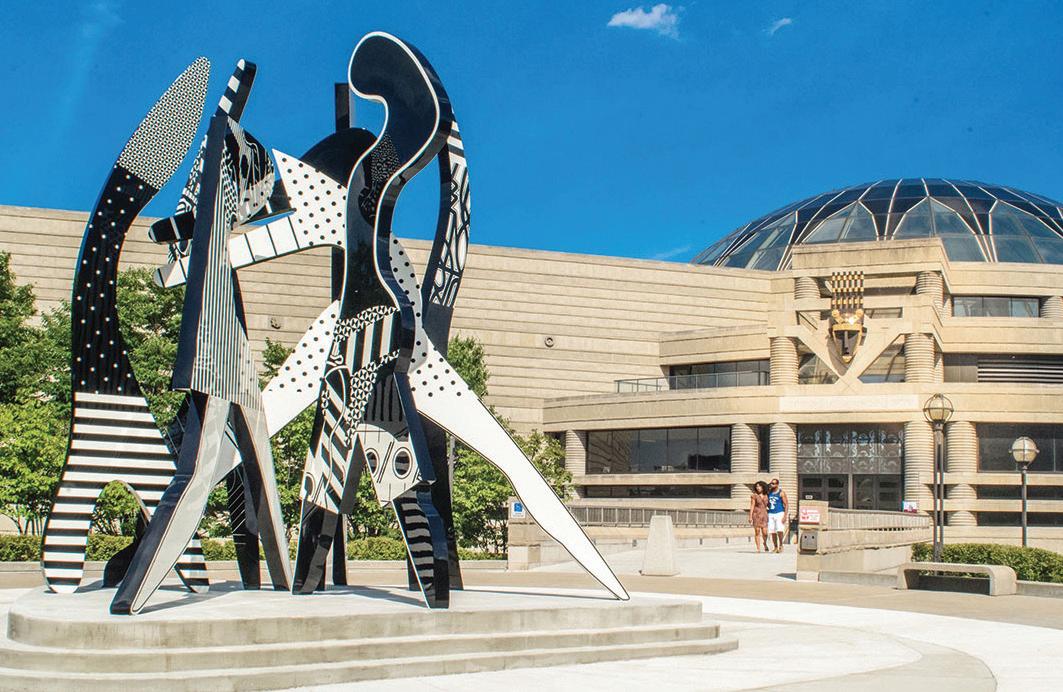



survivor and Andrew Young, a Civil Rights activist.
“It lets you access history differently instead of just reading a panel,” said Courtney Bradford, curator.
Groups of 10 to 30 can tour the center. They can opt for a deep dive into a particular topic of interest; one of the most popular, called “What’s in the Pot?”, explores the history of soul food and its connections to traditional African American cuisine. Catered lunches can be arranged in the center’s ballroom or classroom space.
arkansasheritage.com
Los Angeles, California
Located in Exposition Park in southern Los Angeles, the California African American Museum was founded in 1977 to preserve and collect artifacts related to Black history, art and culture, especially those related to the American West and

California. Its current 44,000-square-foot building was designed by Black architects Jack Haywood and Vince Proby and completed in 1984.
The work of Black artists in the museum’s galleries spans many mediums, from sculptures to photographs to mixed media. Visitors can also peruse historic documents and a research library. While many of its works come from Black artists connected to California or the western United States, there are also works from Haiti, Brazil and Africa. The museum is also a site for community events and programs, such as lectures, yoga classes, conversations with artists and guided walkthroughs.
Admission is free to the museum, which is located near Exposition Park attractions including the California Science Center, the Natural History Museum and the Exposition Park Rose Garden. caamuseum.org
The Harvey B. Gantt Center for African American Arts and Culture is a gem in the Queen City. The center’s namesake Harvey Gantt is an architect and politician known for being Charlotte’s first Black mayor, as well as the first Black student at Clemson University. First opened in 1974 as the Afro-American Cultural Center and named after Gantt in 2009, the 46,500-square-foot building in the heart of Charlotte’s business district is notable for its modern design of crisscrossed glass, metal panels and steel. The design was inspired by the story of Jacob’s Ladder and quilt patterns used the Underground Railroad.
The Gantt Center’s mission is to preserve and celebrate the contributions of African Americans to art, history and culture. Its exhibits highlight visual arts, and its permanent collection contains work from prominent artists such as Jacob Lawrence, Romare Bearden and Jonathan Green. In addition to displaying art, the center hosts lectures by visiting black artists, community art classes and workshops, and events.
“There’s a lot of heritage here at the Gantt,” said Ingrid Travis James, director of marketing and communications. “There’s that longstanding history we have in the Charlotte region, so if you’re from Charlotte, you’ll learn more about your community. And if you’re not from here, you’ll be surprised just how much history and heritage Charlotte has.”
Groups of 10 or more can can choose between a one-hour guided tour of the art and exhibits or couple their tour with an artist-led workshop where they learn about an African American artist and create artwork in that artist’s style, or complete a goal-setting exercise and create a selfportrait. Groups can also arrange for a catered lunch on site in advance. ganttcenter.org

Alea Simone
Alea Simone is a content creator who uses her business savvy and travel experience to create educational content about planning affordable trips and finding hidden gems in destinations around the world. After she quit her day job in 2019, Simone began to grow a following across social media platforms that is now more than 873,000 strong. Her most popular pages are on Instagram and TikTok, but she can also be found on Facebook and Pinterest. Her brand appeals to young, professional women of color who aspire to travel the world. She teaches that with careful planning and some insider tips, luxurious travel experiences are affordable. She also plans and hosts group trips for women to international destinations like Bali, Egypt and Dubai.
Instagram: thetraveltaurus
TikTok: thetraveltauruss
Following: 873,000+

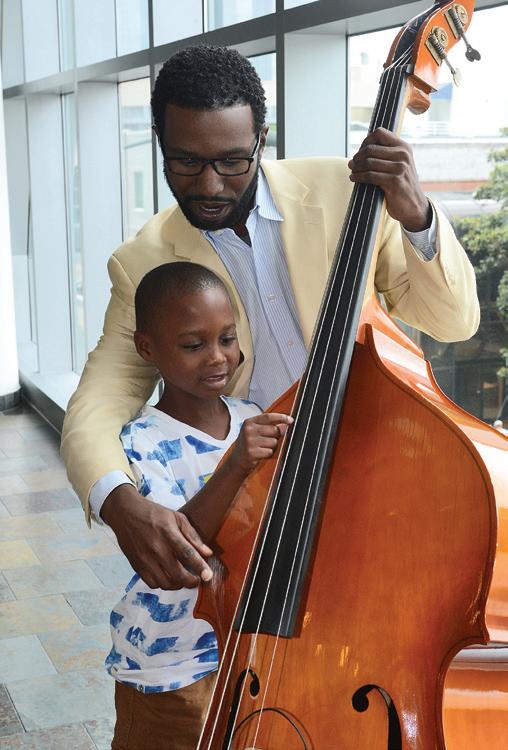




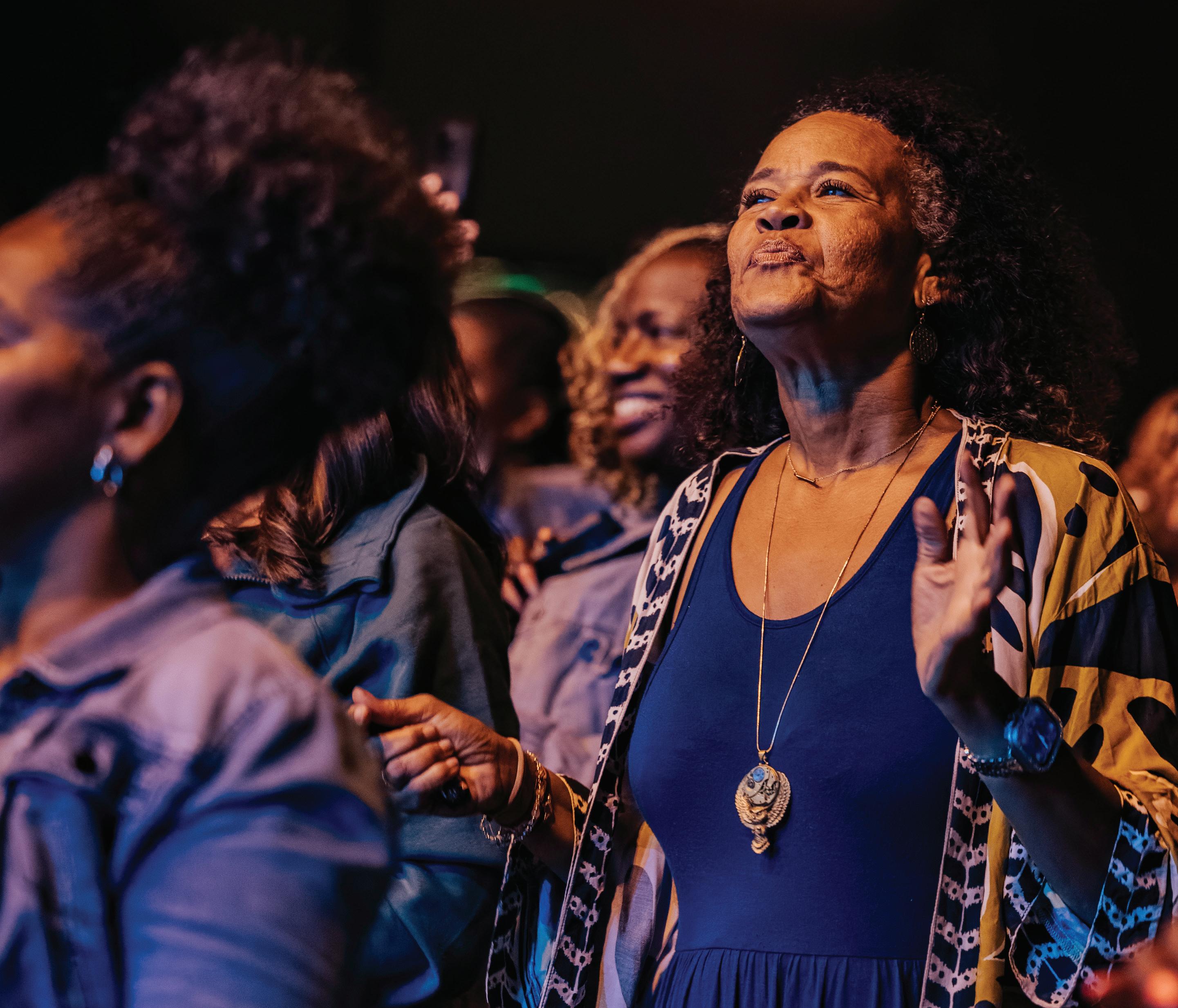



Festivalgoers enjoyed the Black Radio Experience in Napa, which subbed for the annual Napa Blue Note Jazz Festival in 2024.


BY SANDRA JAMALEDDINE, COURTESY BLUE NOTE ENTERTAINMENT GROUP
BY RACHEL CRICK
IT’S DIFFICULT TO OVERSTATE THE IMPORTANCE OF AFRICAN AMERICAN INFLUENCE ON THE MUSIC INDUSTRY.
It can be found in the moving tones of the Blues, the funky beats of soul and the energy of hip-hop. It has impacted gospel, R&B and pop music through the decades.
At Black music festivals, the influence shines bright. Here are five Black music festivals where the African American influence can be heard.
In July 2025, the annual Indiana Black Expo (IBE) Summer Celebration Music Heritage Festival, held annually in Indianapolis, celebrates its 55th year. IBE is a nonprofit organization that promotes advancements for African American youth and families through cultural events and programs. The Music Heritage Festival is the IBE’s largest event and in addition to an outdoor concert, it includes expos, conferences and a film festival. It brings hundreds of Black vendors, artists and businesses to Indianapolis to celebrate Black culture in support of Black youth.
The lineup for Summer Celebration’s 2024 concert included stars like Johnny Gill, Lalah Hathaway and Karyn White, as well as the band Atlantic Starr. In 2023, there were performances from Grammywinner Stephanie Mills, R&B singer-songwriter Howard Hewett, R&B group Dru Hill and The O’Jays on their final tour.
Groups can attend the festival for a night of energetic performances. It’s held at the IU Michael A. Carroll Track and Soccer Stadium, and general admission starts at $10. The All White Affair, an upscale party hosted the day following the concert, also features live entertainment. summercelebration.net
Napa, California
Napa’s Blue Note Jazz Festival is designed to feel as upscale as any other event in California’s wine country as the summer festival celebrates the intersection of jazz and hip-hop over the last 50 years. A relatively new festival first held in 2022, it got its start from the New York branch of the same festival, which began in 2011.
In 2024, the Blue Note Jazz Festival took a break to offer the Black Radio Experience, a Labor Day weekend festival with headline artists including Jill Scott, John Legend and André 3000. Despite this hiatus, the jazz fest plans to return in 2025. Previous lineups featured high-profile headliners, like Mary J. Blige and Chance the Rapper. In 2022 and 2023, the festival was hosted by Dave Chappelle at the upscale Silverado Resort.
The three-day festival spreads out over a large area with multiple stages. It also takes full advantage of the region’s award-winning culinary scene, with local food vendors and wineries on hand. A 21-plus after-party each day gives attendees more opportunities to meet the talent and enjoy live music. bluenotejazz.com/jazz-festival-napa
Nashville, Tennessee
It’s no surprise Music City has its share of popular music festivals. One of its newest, Blavity House Party, focuses on Nashville’s Black culture and music, highlighting R&B and hip-hop performers, sometimes with a hint of country mixed in. The festival, hosted by Blavity Media Group re-creates the fun and intimate atmosphere of a house party and celebrates Black culture. With its energetic atmosphere and prominence of emerging artists, it appeals to Millennial and Gen-Z audiences.
Blavity House Party was held for the first time in June 2024 at the Nashville Municipal Auditorium. Over two days, performers included R&B singer Monica, New Orleans native rapper Big Freedia, rapper and producer Rick Ross and R&B group Dru Hill, among others. Attendees were fueled by more than 20 Black-owned Nashville restaurants and vendors.
Blavity Media Group will host “house parties” in other cities, with the next one planned for mid-November 2024 in Houston. blavity.com



performance at IBE’s Summer Celebration in Indianapolis


This historic cemetery is home to Confederate soldiers� unmarked graves of those thought to be formerly enslaved� as well as Horace King� a former slave who rose to become an accomplished engineer� bridge builder� and state legislator� This memorial honors the lives of those laid to rest there and features an interpretive pavilion� walkways� seating areas� and one of only five remaining King covered bridges� The significance of the site in our collective history is not to be understated� Come explore some of the stories that helped shape our future� VisitLaGrange.com
Oh, The Stories You’ll Tell
Set in the City of Brotherly Love, the Roots Picnic is an annual Black music festival founded by The Roots, the Philadelphia-based hip-hop group that is the house band for “The Tonight Show.” Since it was first held in 2008, the festival has been delighting audiences with its impressive lineups. It is held each summer at the Mann Center in Philadelphia’s Fairmount Park. In June 2024, the Roots Picnic drew in an impressive 60,000 attendees over two days of performances that included rap, hip-hop and R&B sets from André 3000, Jill Scott and Lil Wayne, as well as Victory Monet and The Roots, who frequently perform at the festival. In 2023, the festival’s lineup also included rapper Lil Uzi Vert, songwriter and rapper Lauryn Hill and a comedy performance by Dave Chappelle.
Three stages are set up in the park, including a podcast stage for live podcasts and other experiences. Local, Black-owned restaurants supply refreshments. Single-day tickets are available, as well as VIP tickets with pit access to the stages and meal and drink vouchers. therootspicnic.com
Miami Gardens, Florida
Miami Gardens, a Miami suburb with a population of about 113,000, is also the third-largest predominantly African American city in the U.S. so it makes sense that the multicultural music festival Jazz in the Gardens would be held there. The two-day music festival in March each year is hosted by the city at Hard Rock Stadium, home to the NFL’s Miami Dolphins.
While the festival, in its 17th year, focuses primarily on jazz, R&B, soul and gospel artists are also featured. In 2024, headliners included singer-songwriter Maxwell, R&B singer-songwriter Summer Walker and Nigerian singer Davido. In 2023, the lineup included Jill Scott, Erykah Badu, Charlie Wilson and Ari Lennox. A record-breaking 41,000 people attended in 2024, thanks to a partnership with Black Promoters Collective, which added performers and genres to the mix.
When groups buy general admissions passes, they’ll need to bring their own seating. Food vendors will be located throughout the stadium and festival sponsors will provide games, activities and merchandise. Single-day tickets are available, as are upgraded and VIP experiences, which include parking passes and elevated seating areas with access to an open bar. jazzinthegardens.com

Jeff Jenkins
CHUBBY DIARIES
Jeff Jenkins was a high school choir teacher before he embarked on a journey that would lead to becoming a National Geographic TV host. He began making content about his personal experiences as a plus-sized traveler to break down barriers that deter plus-sized people from traveling and champion diversity within the online travel space. He quickly gained a following through social media and his blog and was eventually offered the chance to host his own television show on National Geographic called “Never Say Never,” which aired in 2023. In this show, he travels the world to prove there’s no limit to the experiences plus-sized travelers can enjoy.
Instagram: chubbydiaries
TikTok: chubbydiaries
X: chubbydiaries_
Facebook: chubbydiaries.com
YouTube: chubbydiaries1
Following: 267,000+
chubbydiaries.com

The stage at Philadelphia’s Roots Picnic festival


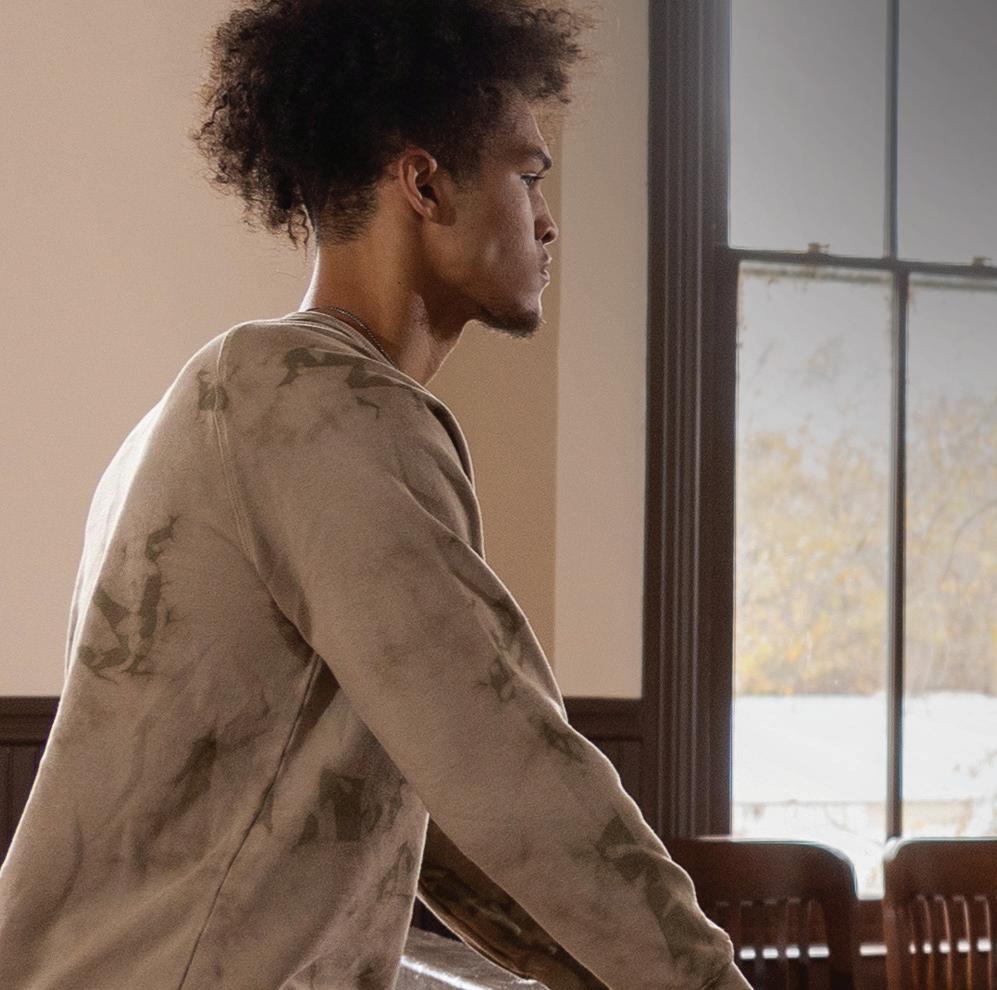


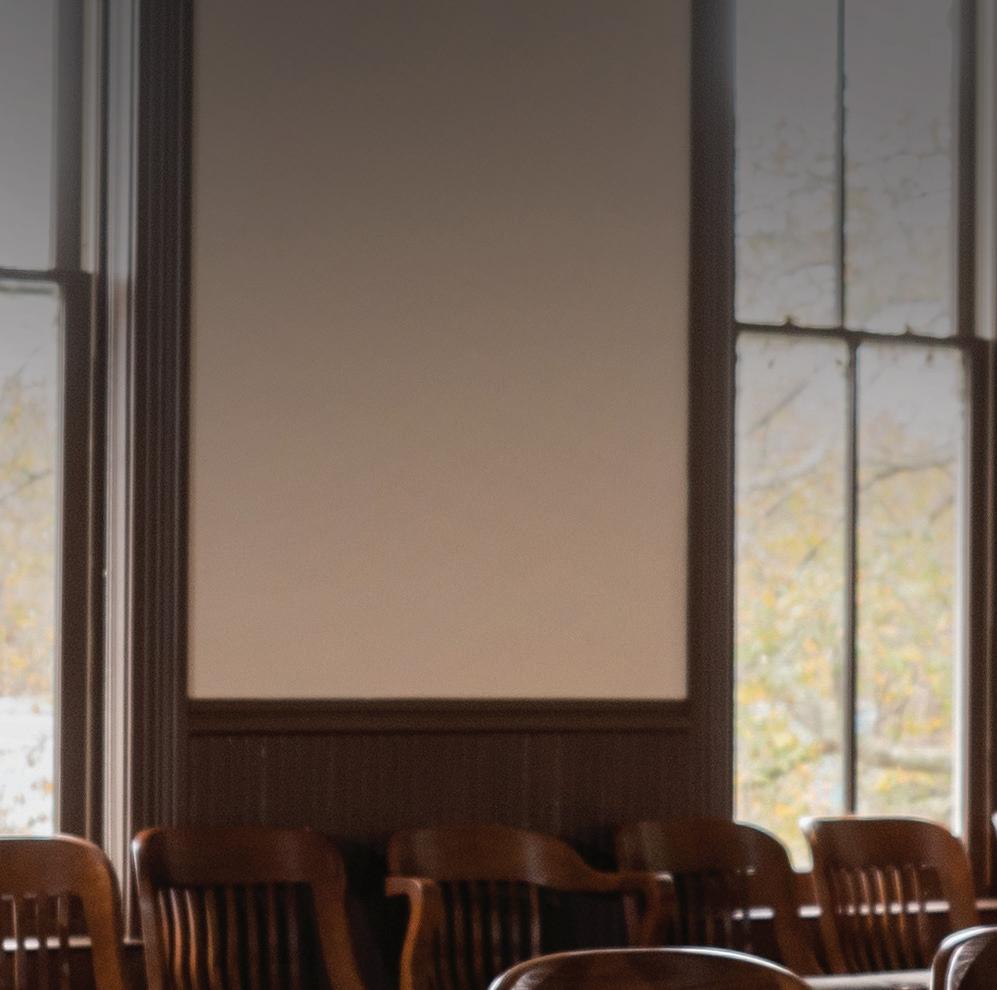









Tulsa’s Greenwood District was once called Black Wall Street because of its prosperous, self-sufficient Black community.

BY RACHEL CRICK
THE STORIES OF BLACK NEIGHBORHOODS AND HISTORIC DISTRICTS ARE INTEGRAL TO AMERICAN HISTORY. These neighborhoods have been scarred by some of the most brutal chapters of history, but they also tell stories of innovation and resilience. They’re the birthplaces of iconic figures in Black history and global movements in the arts, and many continue as thriving epicenters of Black culture and heritage.
Tours of these neighborhoods offer groups multicultural dining, shopping and entertainment experiences, but above all, a chance to learn more about lesser-known yet essential aspects of America’s history.
New York City
Traditional tours of New York City often overlook one of its most authentic experiences: a visit to Harlem. This Upper Manhattan neighborhood covers about three square miles. It’s been home to many different people and cultures: first a Dutch village in the 1650s, then to Jewish and Italian immigrants in the 19th century, followed by African Americans, who moved in during the Great Migration in the 20th century. During the 1920s, Black literature and jazz flourished there, as a cultural movement known as the Harlem Renaissance began. Today, Harlem is known for its Black culture and history, with plenty of jazz clubs, eclectic eateries and beautiful, historic architecture.
Perhaps the best way for groups to experience Harlem is on a walking tour. Harlem Tours founder Carolyn Johnson started the company in 2004 to build awareness of what Harlem has to offer.
“Tourism was starting to come back in Harlem, and I wanted to give a true perspective on it because there were a lot of outsiders,” said Johnson. “It lets them get out of touristy places like Times Square to see the beauty of Manhattan and the boroughs.”

Tours are kept small to create a more intimate experience. Larger groups can be split into smaller ones with additional guides. Tours touch on different topics, from Civil Rights to the Harlem Renaissance to jazz. One of the most popular is the gospel and brunch tour, where a Black gospel concert is paired with the other famous sights and sounds of Harlem, such as the Apollo Theater. All tours make stops for meals at local restaurants. welcometoharlem.com
The Greenwood District in Tulsa, Oklahoma, was such an economically prosperous Black community in the early 1900s that it earned the nickname “Black Wall Street.” The self-sufficient neighborhood had grocery stores, doctor’s offices, hotels and more in 35 square blocks. But in 1921, it became the site of a horrific tragedy, the Tulsa Race Riot, also known as the Greenwood Massacre. The violence began after a Black shoeshine was falsely accused of assaulting a white elevator operator. White rioters invaded Greenwood, burned and looted businesses and homes, and killed residents. The violence ended only after the Oklahoma National Guard was called in. The riot was devastating; As many as 300 Black residents died, more than 10,000 were displaced and property was destroyed or damaged.
Over the next several decades, the community was rebuilt, and when segregation later ended, African Americans began to spread out into the Tulsa community. Today, Black Wall Street is remembered for the tragedy it endured and the resilience of its Black community.
The Black Wall Street Chamber of Commerce does group tours for up to 15 of this once-thriving district. Tours may include Greenwood Rising, also known as Black Wall Street Museum; street art, including murals and sculptures commemorating the neighborhood’s past; the Black Wall Street Memorial; and Vernon AME Church, which survived the riots. Shops and restaurants can be stops along the way. bwschamber.com
Oakland, California
West Oakland, California, has a long history of multiculturalism. In the late 19th century, African Americans from the southern United States migrated to the area, joining the diverse population of immigrants already living there. The neighborhood’s success grew over the next few decades alongside its Black population. West Oakland’s Seventh Street, its main strip, was the center of the community. During its prime, West Oakland was a prosperous Black neighborhood with an exceptional entertainment scene. Jazz clubs and other nightlife drew in renowned performers like Billie Holiday and Aretha Franklin. Though the neighborhood’s prosperity waned in the mid-20th century, it’s currently undergoing a resurgence fueled in part by an interest in preserving its roots.



David Peters founded Black Liberation Walking Tours in 2019 after he moved back to Oakland and noticed a cultural change in the neighborhood.
“The tour came out of an event my wife and I had out of our home, and some older residents started telling stories about what the neighborhood was like when they were younger,” Peters said. “A hush fell over the room. There was a hunger for this information, and I realized I had an opportunity to record the voices of our elders, to save that for posterity, to share that with others in our community.”
The tour began as a self-guided audio walking tour with narratives from Oakland residents and an interactive map. Demand grew, and Peters began offering guided tours for groups of up to 30 on the third Saturday each month, May–November, in addition to private guided tours. Whether groups opt for a guided experience or the self-guided walking tour, they’ll hear firsthand stories of West Oakland’s past and get to know some of the businesses, art and culture that are propelling it forward. blwt.org



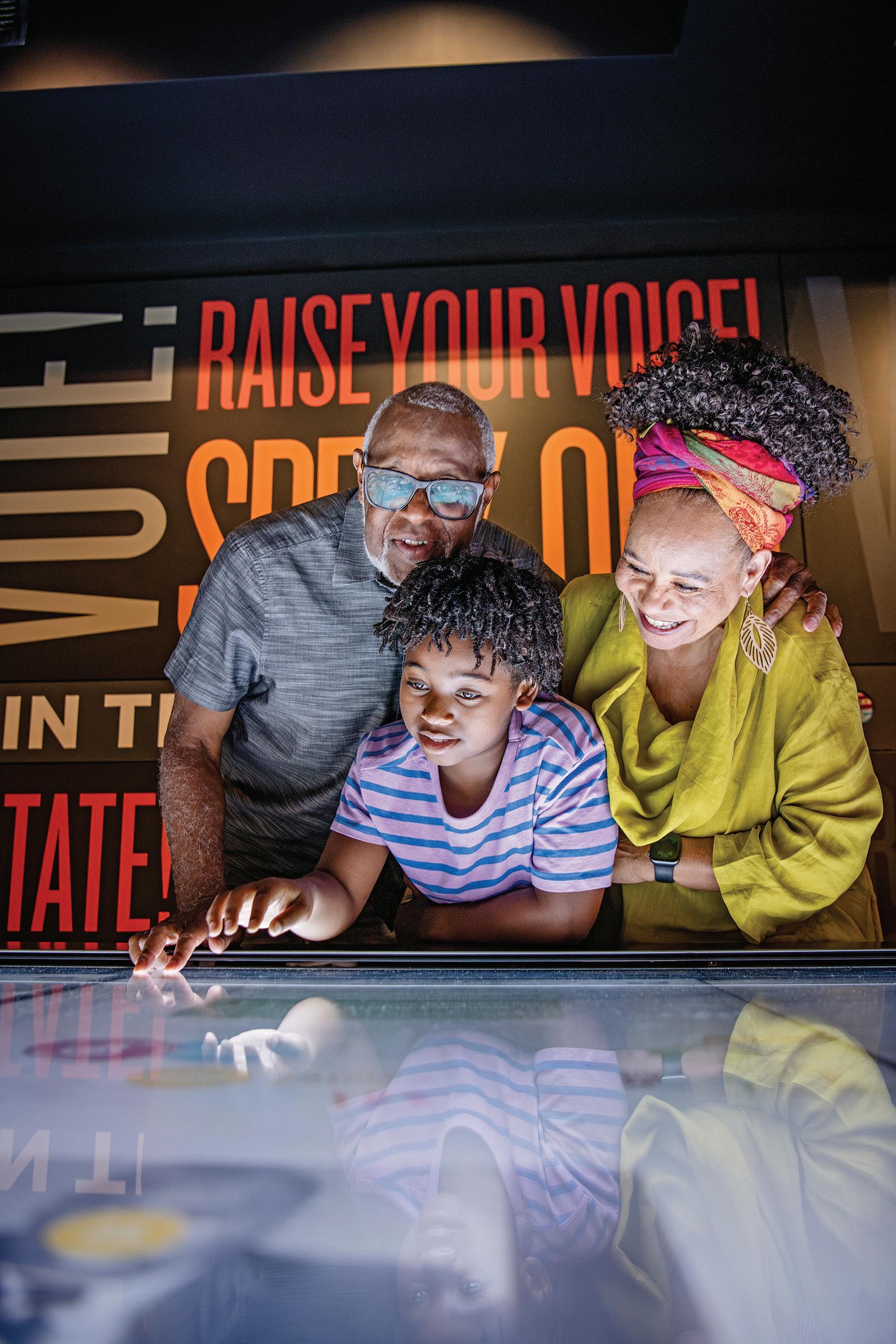

The Hayti District in Durham, North Carolina, was founded in the latter half of the 19th century by African Americans who moved there to work in tobacco warehouses. The community was organized around two churches and a growing number of businesses. Eventually, some residents bought the land their growing community was built on, and large homes and other community assets, including a hospital and library, were built. The neighborhood flourished, becoming self-sufficient and prosperous, until the late 1950s, when it was partially demolished for a new freeway and other urban development projects. Today, the neighborhood’s history is preserved at the Hayti Heritage Center. Groups visiting Durham in early March won’t want to miss the annual Hayti Heritage Film Festival, which showcases films produced by and starring African Americans.
Founded by Aya Shabu, a dancer and teaching artist who lives in Durham, Whistle Stop Tours leads tours of the Hayti District through a partnership with the Hayti Heritage Center. The walking tours last about 75 minutes and stop at sites like St. Joseph’s AME Church, one of the cornerstone institutions of the neighborhood, and the Carolina Times, Durham’s only newspaper for Black residents. Inspiring stories of the neighborhood’s history are performed by guides. The tour company also does tours of two other prominent Black neighborhoods in Durham. A motorcoach tour of all three neighborhoods can be arranged. hayti.org
Atlanta
Located along Auburn Avenue in eastern Atlanta, the Sweet Auburn Historic District is steeped in history. Following the Atlanta Race Massacre of 1906 — when white rioters killed Black residents and destroyed homes and businesses in downtown Atlanta — the city’s Black businesses primarily migrated to what’s now known as the Sweet Auburn Historic District. The district became a thriving epicenter for the city’s Black community as early as the 1920s and achieved great success in the 1940s and 1950s. The moniker “Sweet Auburn” was coined by John Wesley Dobbs, a Civil Rights activist, and in 1956, Fortune magazine named it the wealthiest Black neighborhood in the country. Martin Luther King Jr. was born there, and his activism made it a critical site for the Civil Rights Movement. The neighborhood was named a National Historic Landmark in 1976, and today it’s home to museums, art and heritage sites that pay tribute to its rich history. There are self-guided walking tours, and Roger’s Red Jacket Tours also offers guided tours. Its Sweet Auburn Walking Tour, for groups of up to 12, tells some of the neighborhood’s most powerful stories. Several U.S. Civil Rights Trail sites are in the district, including Ebenezer Baptist Church, King’s birth home and the Martin Luther King Jr. National Historical Park. Other tour stops include the Atlanta Life Building and the office of the Atlanta Daily World, Atlanta’s oldest Black newspaper. rogersredjackettours.com

Ciara Johnson is a Houston-based content creator and travel influencer whose love of travel took off following a semester of study abroad in South Africa. After she graduated and worked a nine-to-five job for two years, she decided to pursue a life in travel and bought a one-way ticket to Mexico. She worked as a part-time travel writer while growing her brand, and today has over 233,000 followers across platforms such as Instagram, TikTok, X (formerly Twitter) and her own blog. She posts content about solo travel as a Black woman, giving advice to help women who are traveling solo check items off their travel bucket lists safely and confidently. She shares her travel experiences, both good and bad, to help travelers plan the best trips and avoid newbie mistakes.
Instagram: hey_ciara
TikTok: hey_ciara
X: hey_ciara
Following: 233,000+
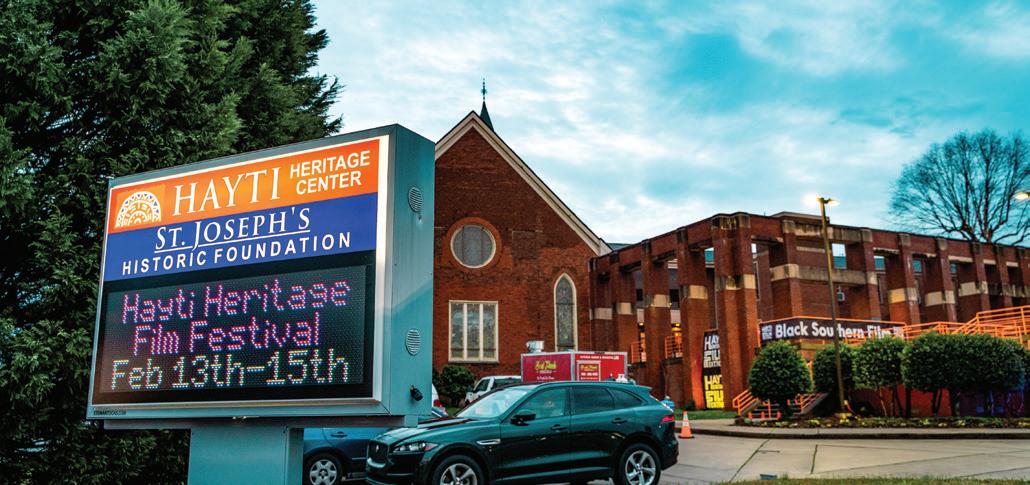
















Are you looking for new ideas in your old favorites or a new destination for your group to enjoy?
Register for one of our FAMs to learn about these great destinations from the local experts.
FAMs are open to tour operators and group leaders with active travel clubs. Participants are responsible for their own travel to and from the destination. All other expenses including hotel accommodations, meals and admissions will be covered by our CVB hosts.

Add an unforgettable destination to your tour. Prepare for a thrilling adventure through biblical history at our life-size Noah’s Ark, located just south of Cincinnati.






